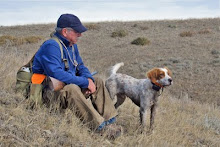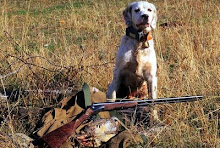While poking around on the subject of AI, I also had a conversation with Solon Rhode who offered this (edited) account of his experience breeding by AI.
One breeder’s experience.
We attempted unsuccessfully to breed our Small Munsterlander bitch Janni last June by natural cover. Both Janni and the stud were inexperienced and we did not get a successful tie until late in her cycle, which was over by day 17. I suspect the reason the mating didn’t take was because we missed the fertile window and this is a common cause of breeding failures.
So we decided on her next cycle to try an AI. There are some advantages to AI, one of the main ones is that it increases the choices of stud dogs. It avoids the expense and stress of shipping the bitch, which may not be possible during times extreme weather conditions. One can also use a stud that is no longer fertile or even still alive, if his semen has been stored frozen.
We selected a young male, Zip, imported from Germany as the stud, for he seemed to be a good complement to Janni. Zip lives 1300 miles away, but shipping semen express by air eliminates the distance factor. Near where Zip lives, we found a vet that was a small animal reproduction specialist to handle the semen collection. Because Zip had not been bred before, a test collection was done prior to Janni’s expected heat cycle to verify his sperm quality and its ability to be preserved. We elected to do a breeding with chilled semen, since Zip is a young dog and insemination with chilled semen does not require a surgical procedure, or even sedation of the bitch. Zip’s semen was high quality and stored well with the extender.
There are many logistical details to be worked out in advance at both ends of the breeding process. The stud owner and vet need to be available on off days for making the collection on sudden notice and I alerted them when Janni went into proestrus. This is important because the optimal time for the insemination is 2 days after ovulation has been determined by progesterone testing (more about that below). Frozen semen has the advantage over chilled semen in that it can be shipped well in advance and stored at the vet until needed. Its disadvantage is it takes a surgical procedure to endoscopically implant it into the uterus. Chilled semen can be put into the uterus trans-cervically using an endoscope too, but that requires some sedation. Our vet says that 90% of the time he can advance a small plastic catheter into the uterus to implant the semen without sedation.
When done by experienced people, AI provides just as high a conception rate and litter size as natural cover, maybe even better. see the Camelot Farms web site, which has a lot of useful information.
The chilled semen is preserved with an extender. We used CaniPro 5 made by Minitube and the Minitube shipping container. The shipping container will maintain the chill for 45 hours or more depending on the temperatures of its environment. The semen was delivered by the vet’s technician to a FedEx office. Be sure that the carrier can deliver overnight – holidays may cause a problem. The semen should be implanted 2 days after ovulation for chilled semen and 3 days after for frozen semen. The sperm has a viability in utero of 24 to 48 hours for chilled semen and only 12 hours for frozen. So with frozen semen, the timing is more critical.
Here is a useful link to the canine estrus cycle and other aspects of canine reproduction.
Determining the time of ovulation is done by tracking the blood progesterone level of the bitch - counting days or judging readiness by the bitch’s level of receptiveness is not very reliable. We did the progesterone testing with an ELISA kit obtained by our vet that cost $211 for ten determinations.
The other tricky part is getting the progesterone levels done. You want to do them in the early part of the day so they are ready for that day blood pickup if they are being sent out and also so you have time to act once ovulation has been determined. The ELISA test takes about an hour, but if you send blood out for a radioimmunoassay, you don’t get the result until the next day.
Janni’s level was done first on day 4 and the result was at the baseline low value of less than 3 ng/ml. The same result was obtained on day 6 of her cycle but then it surprised us and jumped up to greater than 3 and less than 10 on day 8. The threshold of 5 ng/ml indicates that ovulation has occurred. So we were confident she was ovulating on Dec. 31st, day 8-not the best timing for shipping to be sure. Janni has a short cycle, which probably explains why the previous attempt to breed her didn’t work.
I had the blood drawn by the tech at the vet and she ran the tests on days 4,6,and 8. You can do the test every two days until it shows it is increasing and then you should do it daily. Since the day 8 ELISA for progesterone came back greater than 3 and less than 10, it meant ovulation was imminent. So phone calls were made to Zip’s owner and he was able to get the semen collection by that afternoon. Be sure someone involved has a FedEx account well in advance (6 weeks) so the shipment can be done when needed. FedEX has an expedited express service for $180 that will deliver door to door 365 days per year and 24/7. With normal FedEx overnight service the package will not move though on major holidays - as we found out.
The ELISA seems to be an adequate test, but if one is unsure, you can send the blood to an outside lab for a more accurate progesterone measurement. When it rises to 5 or higher, ovulation has occurred. The outside lab tests costs more, about $100 per test and you don't get the result until the next day. More details here.
I drew blood and ran my own progesterone ELISA New Years Day. Because Janni had ovulated so soon, I had plenty of extra sample wells, so I included some additional controls of 5 and 15 ng/ml. The higher the progesterone, the lower the level of color when the reaction is developed. Here is the result:

I read this test as Janni on day 9 was higher than 10 ng/ml and about the same as 15 ng/ml. This confirmed that she had ovulated on day 8.
Insemination: late Friday afternoon Dr. Jeff Meyers in Granville, NY did the first insemination and we repeated it again on Sunday morning. He verified by microscopy that the sperm were in good condition prior to the procedure, although by Sunday they were not quite as good, but adequate.
Dr. Meyers puts one finger into the bitch’s vagina and palpates the cervix while she stands on the examining table. The assistant (me) steadies the dog’s head and pulls her tail to the side. He then slides a long catheter along his finger and passes it well into the uterus, where he delivers the semen sample from a syringe. Afterward, you elevate her rear for a few minutes. That is it and it only takes about 10 minutes.
The total costs not including the stud fee was about $631. This includes $150 for the semen collection, $211 for the progesterone kit, $108 for the vet technician and three blood draws and tests for progesterone levels, $101 for the two inseminations, and $60.66 for the FedEx shipping. It would cost a similar amount to ship a bitch by air to a stud round trip or make a long drive to deliver her. If the breeder bought the Camelot Farms ELISA and did their own assays, that would save about $200 over the costs we incurred.
Unhappily, our effort failed and the breeding did not take. I think we did everything right, but biology is never 100%. The next time I think I will breed Janni by natural cover with a proven fertile male and really see if she is fertile.
Solon Rhode
This concludes our lesson in reproductive biology... it is not nice to fool Mother Nature.









2 comments:
Very informative. I have often wondered about the process and cost of AI. Seems like it has the potential to help the genetics of our animals by making available the most proven strains without many of the limiting logistics.
Really informative article. Breeding has been made very easy with the invention of artificial insemination and I think A.I has been made super easy with the use of A.I kits for dogs.
Post a Comment